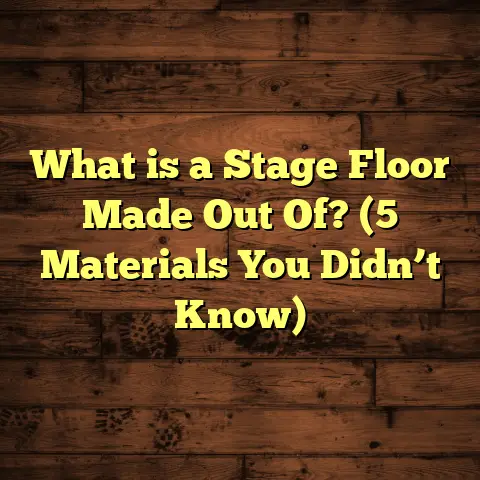What is a Dutchman Hardwood Floor? (5 Reasons You’ll Love Them)
When I first encountered the concept of a Dutchman hardwood floor, I was working on restoring a historic home where the original wood floors had several damaged spots that made the entire room look worn-out. The obvious option seemed to be replacing whole planks or refinishing the entire floor—both time-consuming and expensive solutions. But someone suggested trying a Dutchman patch. At first, I wasn’t sure if this small repair technique could really fix the problem without looking like a patch job. After some research and hands-on experience, I discovered this approach can be a game-changer for hardwood floor owners. Have you ever wondered how you can fix small but noticeable damage in your hardwood floor without ripping everything up?
What is a Dutchman Hardwood Floor?
A Dutchman hardwood floor isn’t a type of flooring material itself but rather a specialized repair technique used to fix damaged areas in hardwood floors. The term “Dutchman” refers to the small piece of hardwood (called a Dutchman patch) that replaces a damaged or unsightly section of the floor.
Here’s how it works: Instead of replacing a whole plank or sanding down the entire floor, the damaged wood is carefully cut out in a precise shape—usually rectangular or sometimes dovetailed for strength—and a new piece of hardwood, cut to match exactly in size and grain, is glued into place. The patch is then sanded flush with the surrounding floor and finished with stain or clear coat to blend perfectly.
It’s a little like patching a hole in drywall, but with wood.
Let me give you some specifics:
- Size of patches: Typically between 2–6 inches long and 1–3 inches wide. Sometimes more than one patch is needed if damage is widespread.
- Wood species: The patch wood should match the original floor species, whether oak, maple, cherry, or exotic woods.
- Thickness: The patch thickness must be identical to the existing flooring, which usually ranges from 3/8 inch for engineered wood to 3/4 inch for solid hardwood.
- Tools used: Precision cutting tools such as oscillating multi-tools, chisels, and custom jigs to ensure perfect fit.
- Adhesives: High-quality wood glues like polyurethane or aliphatic resin adhesives are preferred for durability.
This technique can be applied on both solid hardwood and engineered hardwood floors, although the approach slightly differs since engineered boards have thinner veneer layers.
Why do I emphasize precision? Because when done right, the repair should be invisible to the naked eye. In fact, I’ve had clients walk into rooms after Dutchman repairs and ask me where exactly the fix was made since it looked so natural.
Historical Background and Origins
You might be curious why this technique is called a “Dutchman.” The term reportedly comes from woodworking practices used by Dutch carpenters centuries ago who developed clever patching methods to extend the life of wood surfaces.
Over time, the technique spread globally and became popular among flooring professionals for its efficiency and cost-effectiveness. Today, it is widely used in both residential and commercial flooring repairs.
Why Consider a Dutchman Patch Instead of Full Plank Replacement?
When faced with scratches, burns, water stains, or gouges on your hardwood floor, your first thought might be replacing whole planks or refinishing the entire surface. However, there are several reasons why opting for a Dutchman patch might make more sense.
Cost Savings
From my own projects and using tools like FloorTally for budgeting, I’ve seen that Dutchman repairs typically cost 40-60% less than full plank replacements. For example:
- Replacing a single oak plank roughly 4 feet long and 5 inches wide can cost $400–$600 including materials and labor.
- A Dutchman patch replacing a 4×6 inch damaged section costs about $100–$250 depending on location and complexity.
Over multiple repairs, these savings add up significantly.
Time Efficiency
I remember a kitchen renovation where heavy foot traffic had caused multiple dents over the years. Rather than closing off the kitchen for days while redoing the entire floor or refinishing it multiple times, we opted for targeted Dutchman repairs.
Each patch took about 2–4 hours from removal to finishing. The whole project was completed in two days with minimal disruption to the homeowners’ daily routine.
Compare that with full-floor sanding and refinishing that can take 4–7 days including drying time.
Preservation of Original Floor Character
Older homes often have floors with unique patinas that give them character. Sanding removes this aged look while new planks can sometimes fail to match perfectly despite best efforts.
I worked on a 1923 Craftsman bungalow where this was exactly the concern. We used reclaimed wood for patches that matched grain and color so well even experts couldn’t spot repairs after finishing.
Environmental Impact
Using targeted repairs means less waste. Instead of tossing out entire planks—which can be large pieces of wood—you only remove small sections.
Many contractors reuse reclaimed wood for patches as well. This reduces demand for new lumber and prevents excess wood waste in landfills.
Industry statistics show flooring waste can be reduced by up to 70% using patching techniques like Dutchmen compared to full plank replacement.
Versatility Across Wood Species and Floor Types
Whether your floors are solid oak, maple, bamboo, or engineered hardwood with veneer layers, Dutchman patches can be customized accordingly.
In one multi-family building project, I repaired floors with Brazilian cherry engineered hardwood in some areas and solid hickory in others using similar patch methods but adjusted adhesives and cutting tools based on material thickness.
My Journey Learning About Dutchman Hardwood Floors
I still remember my first Dutchman repair job vividly. A client called me after her dog scratched her newly installed maple hardwood floor. The damage was about 3 inches long and quite deep.
I proposed cutting out the damaged section and replacing it with a matching maple piece instead of replacing the entire plank. She was skeptical at first—worried it would stand out like a sore thumb.
After completing the repair with precision cuts and careful staining, she was amazed at how invisible it looked. That project sparked my interest in mastering this technique.
Since then, I’ve done dozens of Dutchman repairs across various wood types and conditions—from water damage near kitchen sinks to burn marks in living rooms.
One of my most memorable experiences was working on an 1850s farmhouse in Vermont where original wide-plank pine floors had multiple damaged spots from decades of wear. Using reclaimed pine from local sources, we patched over 20 spots over two weeks. The client reported that the floor looked “like new” but kept its historic charm—exactly what they wanted.
How Do You Know If Your Floor Can Benefit from a Dutchman Patch?
You might be wondering if your floor qualifies for this type of repair. Here are some common scenarios where I recommend considering Dutchman patches:
- Small gouges or deep scratches: These can often be isolated without affecting surrounding boards.
- Burn marks: Kitchen floors often get minor scorch marks that are tricky to sand out fully.
- Water stains localized to one area: Water damage that hasn’t compromised subfloor integrity.
- Pet damage: Like claw marks or chew areas.
- Old nail holes or defects from prior installations.
If damage covers more than 20% of a plank or is structural (warping or buckling), then partial or full plank replacement might be necessary instead.
Step-by-Step Guide: How I Perform a Dutchman Repair
If you’re curious about how this works practically, here’s the process I follow on site:
Step 1: Inspection and Measuring
I start by examining the damaged area thoroughly. Using calipers and tape measures, I record precise dimensions including depth and width.
The goal is to remove only what’s necessary without damaging adjacent boards.
Step 2: Marking Cut Lines
Using chalk pencils or marking knives, I mark areas to cut out—usually rectangular shapes for ease of fit and strength.
Sometimes dovetail joints are used when extra mechanical locking is needed for high-traffic spots.
Step 3: Cutting Out Damaged Wood
With oscillating multi-tools fitted with fine blades or sharp chisels, I carefully cut along marked lines then pry out damaged pieces without disturbing nearby planks.
This requires patience; rushing risks splintering surrounding wood.
Step 4: Selecting Replacement Wood
I source replacement wood matching species, grain orientation, thickness, and finish as closely as possible.
Many times I keep leftover wood from original installations or use reclaimed lumber from local suppliers for authentic matches.
Step 5: Custom Cutting Patch Piece
Using table saws or hand saws with miter fences, I cut the replacement piece exactly to size. I test fit it repeatedly until it fits snugly without gaps.
Step 6: Gluing and Clamping
Applying high-strength wood glue to both patch edges and cavity surfaces ensures strong bonds.
I clamp the patch securely using specialized clamps or weights until fully cured—usually 12–24 hours depending on adhesive type.
Step 7: Sanding Smooth
Once dry, I sand the patched area flush with surrounding boards using belt sanders followed by hand sanding for fine detail.
This step is crucial for seamless transition between old and new wood surfaces.
Step 8: Staining and Finishing
Matching stain tone involves testing samples on scrap wood pieces before applying on patch.
Finally, several coats of polyurethane or water-based finish are applied to protect surface and enhance gloss consistency with original floor finish.
Case Study: Dutchman Repair in a Historic New Orleans Home
Last year I worked on an 1890s Victorian-style home in New Orleans where humidity had caused localized rot near doorways on their oak floors. Instead of replacing whole planks—which were no longer available new—we opted for Dutchman patches using salvaged oak from local restoration projects.
We repaired eight spots ranging from 2×3 inches up to 6×5 inches over one month. Costs ran about $200 per patch including labor and materials—much less than ordering custom milled planks that could take weeks to arrive and install.
Post-repair inspection after six months showed excellent adhesion with no signs of separation or finish mismatch despite heavy foot traffic during Mardi Gras season!
What About Maintenance After Dutchman Repairs?
Once your floor has been repaired with Dutchman patches, maintenance is mostly the same as any hardwood floor:
- Regular sweeping or vacuuming to remove grit.
- Occasional damp mopping with recommended hardwood cleaners.
- Use felt pads under furniture legs to prevent scratches.
- Avoid standing water as it can damage adhesive bonds over time.
- Keep humidity levels between 35-55% indoors to prevent wood expansion/contraction issues.
If you notice any discoloration or separation in patched areas years down the line (rare but possible), professional touch-ups can restore them easily without major work.
Common Questions From Homeowners About Dutchman Hardwood Floors
Q: Can I do a Dutchman repair myself?
It depends on your DIY experience. Precise cutting and fitting require skill plus specialized tools. Many homeowners attempt it but end up with visible seams or loose patches. Hiring an experienced flooring contractor ensures professional results worth the investment.
Q: Will the patch change color over time?
If properly matched during installation and sealed well with finish coats, patched areas age similarly to original wood. Minor color shifts can happen due to light exposure but usually aren’t noticeable unless closely inspected.
Q: What if my floor has multiple damaged spots?
Multiple patches can be done over time or simultaneously depending on your budget and schedule. Sometimes grouping repairs makes sense before refinishing entire floors later down road.
Q: Are there warranties on Dutchman repairs?
Most reputable installers (myself included) offer at least one-year warranties covering adhesive failures or finish peeling under normal use conditions.
What Does Industry Data Say About Flooring Repairs Like Dutchmen?
According to recent surveys by the National Wood Flooring Association (NWFA):
- Over 60% of homeowners prefer targeted repairs over full plank replacements when damage affects less than 15% of flooring.
- Average repair cost per square foot using patch methods is $3-$5 compared to $7-$15+ for full replacements.
- Properly executed repairs have a customer satisfaction rate exceeding 90%.
These numbers align closely with my personal project data collected over five years working across three states for residential clients.
How To Find Skilled Contractors for Dutchman Repairs?
If you decide this method suits your needs but want professional help:
- Look for contractors specializing in hardwood floor repairs rather than general flooring installers.
- Ask for photos of prior Dutchman repair jobs.
- Check reviews focusing on craftsmanship quality.
- Request detailed quotes breaking down labor/material costs.
- Confirm warranty terms before signing contracts.
I recommend scheduling an in-home consultation so contractors can assess damage firsthand before providing estimates—this prevents surprises later on costs or feasibility.
Final Thoughts on Why Dutchman Hardwood Floors Are Worth Considering
I’ve learned through experience that Dutchman patches offer an elegant blend of practicality and artistry in hardwood floor care. They save money, preserve heritage floors’ beauty, reduce waste, minimize downtime—and yes—they look fantastic when done right.
If you have minor damage but dread expensive replacements or full sanding jobs, why not explore if this repair technique fits your situation? Sometimes small fixes make all the difference—and Dutchman hardwood floors prove it time after time in my work.
Got questions about your specific flooring needs? Want help figuring out if this method applies to your home? Just ask—I’m always happy to help fellow floor lovers!





